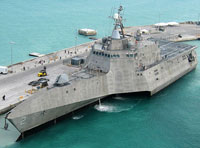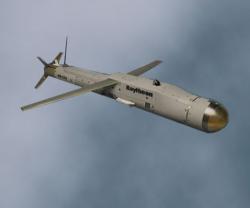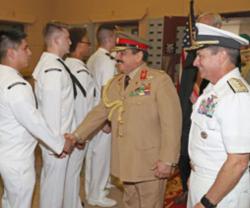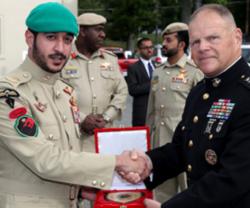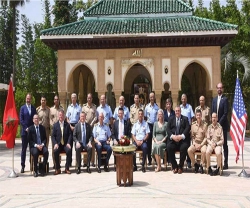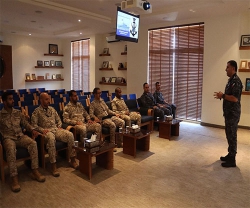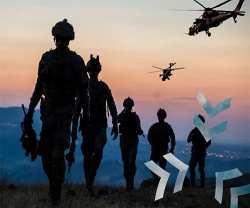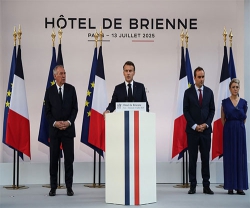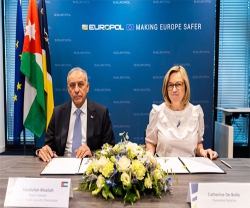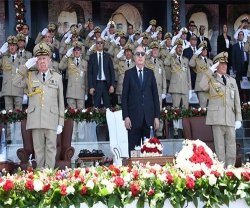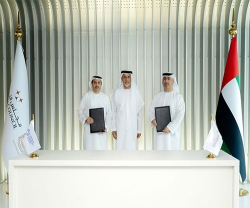Austal Holds Confirmed Contracts for 14 U.S. Navy Ships
20.03.2012 North America
Austal’s order backlog has grown by US$691 million as a result of 2 additional Littoral Combat Ship (LCS) contract options being exercised by the U.S. Navy.
The contract options fund construction of the Gabrielle Giffords (LCS 10) and Omaha (LCS 12), the 3rd and 4rth ships in the 10 ship block buy award made to an Austal-led team in December 2010. That 10 ship program is potentially worth over US$3.5 billion.
Reflecting Austal’s growing stature in naval shipbuilding, Austal USA now holds confirmed contracts for 14 U.S. Navy ships while its Australian operation has a contract to build and support eight patrol boats for the Australian Customs and Border Protection Service.
The U.S. Navy work includes contracts for nine Joint High Speed Vessels (JHSVs), two of which were confirmed in February. It also includes the Coronado (LCS 4) which Austal was contracted to build as part of a General Dynamics Bath Iron Works team prior to taking over as the prime contractor for the 10 ship LCS award. LCS 4 and the first JHSV, USNS Spearhead, are currently being prepared for sea trials, with three other ships currently under construction in Austal’s Mobile, Alabama shipyard.
Austal’s Chief Executive Officer Andrew Bellamy said the company’s U.S. Navy programs provide predictable revenue and workload for years to come.
“The LCS and JHSV programs alone are likely to generate nearly $900 million in revenue per year for the next few years. With series production on both ship classes now underway, we can focus on achieving higher production efficiency and bringing our Navy customer improved cost and schedule performance,” he said.
“The LCS award called for 2 ships to be contracted by the end of March this year, and each of the next 3 years. While these options were expected, it is still pleasing to see the contracts executed, particularly in a period when the U.S. government budget is under pressure.
“Looking ahead, we can now focus on the Defense budget request for the next fiscal year which foreshadows the award of our next two LCSs and our tenth Joint High Speed Vessel. The Navy’s effort to continue procuring these vessels demonstrates the value the U.S. military sees in our platforms,” he said.
Bellamy noted that the Secretary of Defense, Leon E. Panetta, had restated the importance of the LCS when announcing major Budget decisions in January.
“Secretary Panetta said the Navy was protecting what he described as its ‘highest-priority and most flexible ships’ and included Littoral Combat Ships in that category,” he said.
More recently Secretary of the Navy, Ray Mabus, reaffirmed the Navy’s intention to acquire 55 LCSs. In testimony to the House Appropriations Subcommittee on Defense on 1 March SECNAV Mabus stated: “I think the LCS is clearly going to be one of the backbones of the fleet as we go forward. We are committed to buying over 55 of these very capable ships.”
The contract options fund construction of the Gabrielle Giffords (LCS 10) and Omaha (LCS 12), the 3rd and 4rth ships in the 10 ship block buy award made to an Austal-led team in December 2010. That 10 ship program is potentially worth over US$3.5 billion.
Reflecting Austal’s growing stature in naval shipbuilding, Austal USA now holds confirmed contracts for 14 U.S. Navy ships while its Australian operation has a contract to build and support eight patrol boats for the Australian Customs and Border Protection Service.
The U.S. Navy work includes contracts for nine Joint High Speed Vessels (JHSVs), two of which were confirmed in February. It also includes the Coronado (LCS 4) which Austal was contracted to build as part of a General Dynamics Bath Iron Works team prior to taking over as the prime contractor for the 10 ship LCS award. LCS 4 and the first JHSV, USNS Spearhead, are currently being prepared for sea trials, with three other ships currently under construction in Austal’s Mobile, Alabama shipyard.
Austal’s Chief Executive Officer Andrew Bellamy said the company’s U.S. Navy programs provide predictable revenue and workload for years to come.
“The LCS and JHSV programs alone are likely to generate nearly $900 million in revenue per year for the next few years. With series production on both ship classes now underway, we can focus on achieving higher production efficiency and bringing our Navy customer improved cost and schedule performance,” he said.
“The LCS award called for 2 ships to be contracted by the end of March this year, and each of the next 3 years. While these options were expected, it is still pleasing to see the contracts executed, particularly in a period when the U.S. government budget is under pressure.
“Looking ahead, we can now focus on the Defense budget request for the next fiscal year which foreshadows the award of our next two LCSs and our tenth Joint High Speed Vessel. The Navy’s effort to continue procuring these vessels demonstrates the value the U.S. military sees in our platforms,” he said.
Bellamy noted that the Secretary of Defense, Leon E. Panetta, had restated the importance of the LCS when announcing major Budget decisions in January.
“Secretary Panetta said the Navy was protecting what he described as its ‘highest-priority and most flexible ships’ and included Littoral Combat Ships in that category,” he said.
More recently Secretary of the Navy, Ray Mabus, reaffirmed the Navy’s intention to acquire 55 LCSs. In testimony to the House Appropriations Subcommittee on Defense on 1 March SECNAV Mabus stated: “I think the LCS is clearly going to be one of the backbones of the fleet as we go forward. We are committed to buying over 55 of these very capable ships.”
Previous PostNGC to Supply LAIRCM Systems to U.S. Air Force
Latest news
Latest events
IDEF 2025 Turkey - International Defence Industry Fair
22 - 27 Jul 2025Istanbul Expo Center - TurkeyDSEI 2025
09 - 12 Sep 2025Excel, London - United KingdomIntersec Saudi Arabia
29 Sep - 01 Oct 2025Riyadh International Exhibition & Convention Centre - Saudi ArabiaDubai International Air Chiefs’ Conference (DIACC 2025)
16 Nov 2025Atlantis, The Palm Dubai - United Arab Emirates

